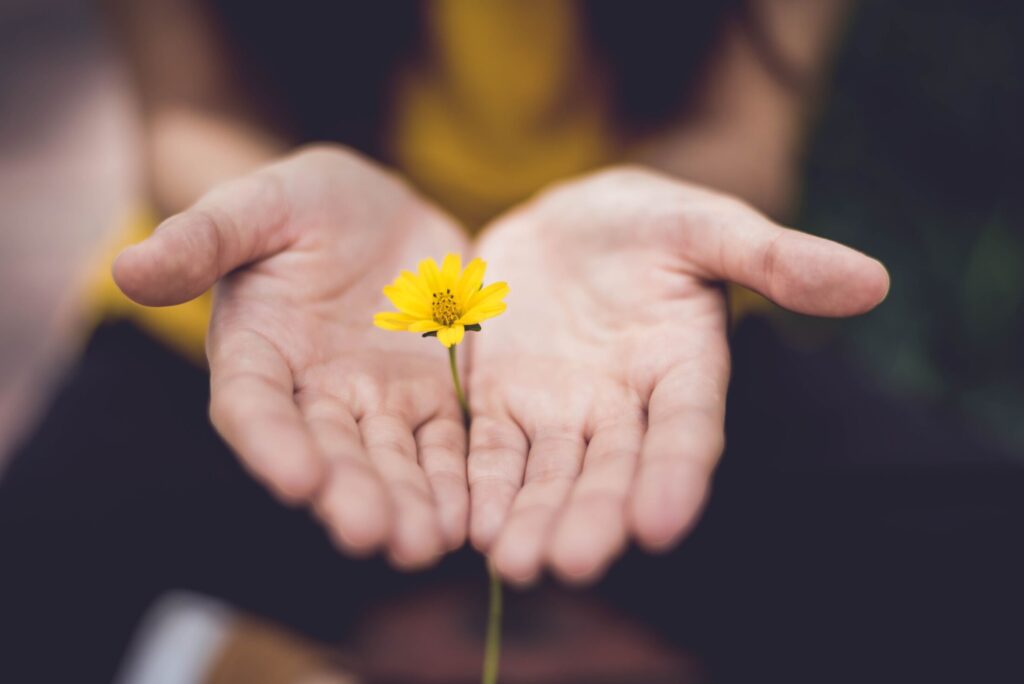
Photo by Laurie Byrne
I remember the first time I took a Mindful Self-Compassion (MSC) course. I had just finished Mindfulness-Based Stress Reduction (MBSR) and wanted to keep learning all I could about the subject. MSC was described to me as taking a bit of a turn from MBSR: I would learn to utilize mindfulness especially during times when I was struggling in some way. Then, I would employ a self-compassion element as a means of learning to be kinder to myself.
Sounded good. I signed up.
I remember a few of the participants and some of the thoughtful struggles we shared during our eight weeks together. And though I gleaned so much from each of our sessions, one of my favorite memories is the time when we learned the three gestures of MSC.
Three gestures of MSC is an exercise that offers participants what my instructors called ‘an embodied experience of mindfulness, common humanity, and self-kindness: the three components of Mindful Self-Compassion.’ Each of these three components had a corresponding movement or gesture that participants learned and could practice.
I am mostly an experiential, kinesthetic learner: I absorb information much better when I move my body, or interact in a more hands-on, participatory way. Though I love to read, research, and study, put me in a room with someone who demonstrates what they’re teaching in an illustrative way and the information clicks for me like the seatbelt in a brand new car: I get it. I’m engaged. My brain swirls with creative ideas and discovery.
What works better for you? Reading instructions or watching someone show you how to accomplish a new skill? One way isn’t better than the other, it’s just different. And in our age of TikTok and YouTube, the latter seems to be more of the norm, though not all of us have access to the internet 24/7. Nor do all of us prefer the screen over reading or doing.
When I grew up, computers and cell phones were not yet on the horizon. I lived a few miles out of town on a small farm in eastern Washington. I built forts with my brother from Dad’s scrap wood, stretched out on our grassy lawn, or sat in the hay with the kittens. And as often as I could, I rode our Shetland pony, Peanuts, after doing whatever chores I was assigned for the day.

Photo by Zoysia Korcz
Peanuts took me on fun rides in the pasture, walking the perimeter of the fence or occasionally trotting me back to the barn. To a bystander it may have seemed like I knew what I was doing while I balanced myself on Peanuts’ bare back and hung on to the reins. But guess what was really happening: I was going along for the ride. Peanuts was an older, retired show pony with a mind of her own. I hadn’t yet learned the skills to keep her heading in the direction I wanted her to go. As a result, Peanuts gave me the ride she wanted to give me.
To have a different experience with her, I needed some training. I picked up books at the library, the “H” encyclopedia from our shelf, and started reading. But my book studies only took me so far. I needed in-the-saddle experience with a good teacher and a willing horse to really learn how to ride.
So it was for me when I first learned Mindful Self-Compassion. I practiced the core meditations of Affectionate Breathing, Loving-kindness, and Giving and Receiving Compassion as they were described to me in class. I read about them in my MSC workbook and listened to recordings from my teachers. The practices were OK, though they didn’t really grip me with self-compassion at first. Like my horseback riding with Peanuts, I knew a few basics in my head. That was about it.
But when the gestures of MSC exercise showed up – my learning took a leap forward. These simple body movements gave me the felt sense of what mindful self-compassion was really like. Things began to click.

Photo by Pop-Zebra
Want to experience the three gestures of Mindful Self-Compassion yourself? If so, feel free to try these instructions with me for the next few paragraphs.
First, tighten both of your fists. This is to simulate what it’s like to resist painful circumstances or difficult emotions in our lives. Ouch.
After squeezing your fists tighter and tighter for a few more seconds, open them slowly and see what you notice.
Fingernail prints and throbbing in the palms, perhaps? Stiff fingers? “That’s mindfulness,” my teachers said. That’s because we’re paying attention, on purpose, to what our unfurling fists – fingers and palms – feel like right now, in this moment.
Next, put your two arms out in front of you at shoulder level as though you are holding a beach ball or a large globe. This motion creates a space right in front of your body where that ball or globe could easily fit. “That’s common humanity,” we were told. The space that your outstretched arms make is enough for someone to fit into: maybe someone you would like to hug or tell, “I’m so sorry for your pain. I get it. Me, too.” This gesture for common humanity reminds us that we’re not alone when we struggle, though struggles can definitely feel very isolating at times. It also helps us embody the fact that other people have the same challenging feelings or experiences that we do. We’re all human.
Finally, stretch both arms straight out in front of you with palms facing up. Then, place one hand in the other hand’s palm so that your first hand is actually resting on the second. Then, hug your elbows to your waist and bend your arms up toward your chest so that both hands come to rest on your sternum.
See if you can feel the gentle pressure and warmth from your hands on your heart. “This signifies self-kindness,” we were told, the third component of Mindful Self-Compassion. The instructor continued, “Is there something kind you could say to yourself right now simply to meet yourself in a gentle way?” If you can’t think of anything to say to yourself, you can try to think of what you might say to a dear friend who is experiencing a struggle that is similar to yours.

Photo by Lina Trochez
Once finished, our MSC instructors gave us some extra time to practice the gestures on our own while standing in the circle. They reminded us, “These gestures are meant to embody the loving, connected presence of MSC: to give you a felt sense of mindfulness, common humanity, and self-kindness.”
Yes, I thought. I feel it: These gestures embodied the Mindful Self-Compassion I’d been learning about in the reading and practices.
Once I experienced the three components of MSC in this hands-on way, my head knowledge expanded to my heart. I went back to my seat and quickly jotted down some notes so that I could correctly repeat these movements again later, after class. Then at home, I kept practicing them so I wouldn’t forget.
For some of us, employing the body components of MSC might make matters worse rather than better. This can happen for a number of reasons and doesn’t mean we’re doing anything wrong. The authors of the MSC program, Drs. Kristin Neff and Chris Germer, repeatedly encourage MSC participants to tweak and edit practices until they work for each of us. In fact, the quintessential MSC question is, “What do I need right now?” Being curious about the answer to that question can be a wonderful part of the learning experience…even when it means stopping in the midst of an exercise or not doing a practice altogether.
What I needed when I wanted to learn to ride a horse was hands-on training and life experience. For me, it’s been the same with learning MSC. Just like the “H” encyclopedia said, I knew the steps for how to hoist myself into the saddle or nudge a horse to walk, trot, or canter. But what a thrill I felt the day I sat atop a young, well-trained horse and had a teacher actually show and teach me how to do and embody these skills.
How about you? Any ideas percolating about how to take your learning to a deeper level? Maybe there’s a tweak you’ve considered trying with one or some of your practices but haven’t undertaken quite yet. Or is there a small, subtle gesture you could offer yourself to express a favorite loving-kindness phrase without words? You might experiment…and see if giving yourself some freedom breathes something new into your practice, too. Whatever you try, do your best to be kind to yourself, like you would to a dear friend in the same situation. See how that goes and how that feels.
Or maybe you’d like to explore the MSC class with us here at Mindfulness Northwest. Upcoming offerings, both in-person and online, can be found here.
P.S. Want to learn three more gestures for MSC? Kristin Neff’s book, Fierce Self-Compassion, describes the three gestures of Yin Self-Compassion (described above) as well as three more gestures for the three elements of Yang Self-Compassion (motivating, providing, and protecting). For a video recording of me showing how to do all six gestures of MSC, click here.
